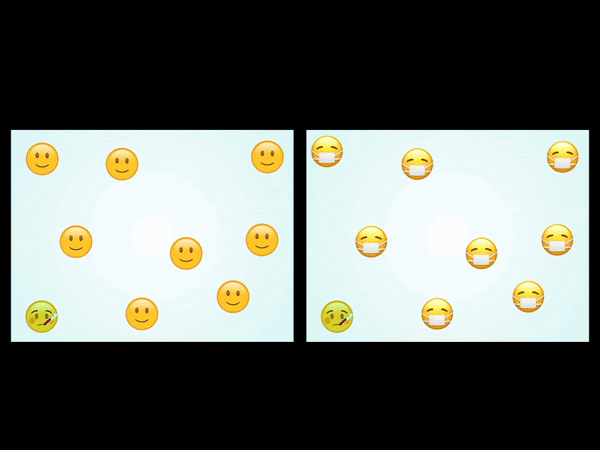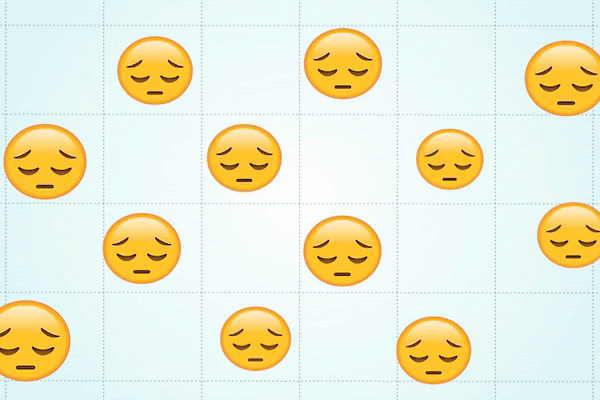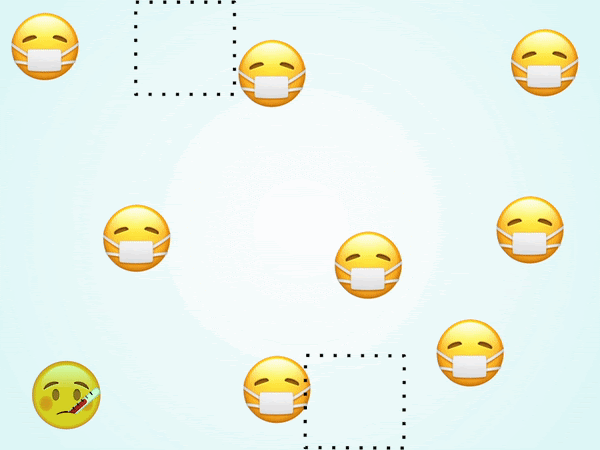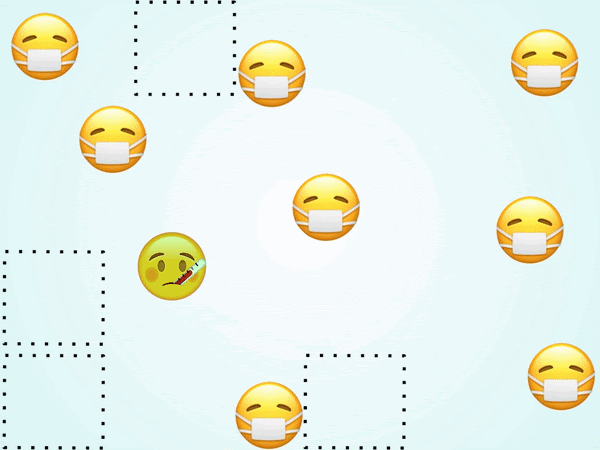Without social distancing, quarantine, or other measures, a virus like COVID-19 can spread rapidly through the population. COVID-19 spreads most easily between people within close distances via droplets in the air created while coughing, sneezing, or talking. People can become contagious before their symptoms appear, or they may never develop symptoms, so it is possible to transmit the disease without a person realizing they are infected. If the virus is allowed to spread too quickly, it can overwhelm the capacity of healthcare services, resulting in less access to treatment and a higher rate of deaths.
 Wearing a mask is a great way to slow transmission and save lives, but masks alone cannot prevent every case. Personal protective equipment can be prone to human error or inconsistent use, and it is less effective when people are in close contact over a long period of time.
Wearing a mask is a great way to slow transmission and save lives, but masks alone cannot prevent every case. Personal protective equipment can be prone to human error or inconsistent use, and it is less effective when people are in close contact over a long period of time.
How Widespread Quarantine Works
The quickest way to slow the spread of the virus is a universal quarantine, where everyone stays isolated regardless of their infection status. While this stops the virus in its tracks, a full quarantine is difficult to maintain over a long period of time, since people still need access to food and medicine, and other essential services. Lifting a quarantine too soon without additional measures in place comes with the risk of a second wave of infections, as we are currently seeing in many countries around the world. Some countries have responded to their second wave with geographically restricted or partial quarantines in “hot-spot” areas.
 Complete quarantines, where everyone in a geographic area stays isolated regardless of their infection status, can stop the spread of COVID-19 in its tracks. However, this can be difficult to maintain over the long term without major disruptions to essential services and economic activity.
Complete quarantines, where everyone in a geographic area stays isolated regardless of their infection status, can stop the spread of COVID-19 in its tracks. However, this can be difficult to maintain over the long term without major disruptions to essential services and economic activity.
How Manual Contact Tracing Works
A second effective measure for slowing the spread of the virus is contact tracing, which works by having potentially infected people, who have been identified by patient interviews and outreach to their circle of contacts, isolate themselves during the time they are contagious. It is similar to the partial quarantine described above, but is more targeted towards the people who are suspected of being infected.
Traditionally, this method works by having contact tracers interview every known infected person, then follow up with all their recent contacts, who go into quarantine to avoid spreading the virus. However, this method requires the infected person to know and remember the people who they had contact with over the past couple weeks.
Being a contact tracer is very time-intensive work, not unlike being a detective. Think back. Would you be able to remember every cashier you interacted with over a two week period? Or know who stood next to you in line? As a result, contact tracing becomes less effective when there is a high number of cases, simply due to the lack of infinite time and resources.
Contact tracing operations also face some unique challenges in the United States. First, many people in the US don’t answer calls from unknown numbers, so manual contact tracers often struggle to reach contacts of infected individuals. Second, while many people altruistically participate in the process and help contact tracers, some find the process invasive of their privacy and hesitate to share this information with authorities.
 Contact tracing allows for a smarter, more targeted quarantine, where only those who came into contact with an infected person are required to isolate themselves. However, it can be very difficult to discover and notify every person who may have been exposed.
Contact tracing allows for a smarter, more targeted quarantine, where only those who came into contact with an infected person are required to isolate themselves. However, it can be very difficult to discover and notify every person who may have been exposed.
How Exposure Notification Apps Can Help
To supplement manual contact tracing, new contact tracing apps have been developed to automate the process. While these apps have been shown to be effective in slowing the spread of COVID-19, many of them also come at the expense of personal privacy. This is particularly true for apps that use GPS location data, which can also be a security risk for many users. It also can result in an over-collection of data for many individuals who may have been near the infected person, but not necessarily in direct contact.
Enter Covid Watch, an exposure alert app that allows contacts to be notified anonymously of exposure, rather than being identified, tracked or traced. It helps notify people more quickly if they may have been infected, who otherwise might fall through the cracks of manual contact tracing. Covid Watch eliminates the need for an infected person to remember every single person they interacted with, since their mobile device can anonymously remember other anonymous mobile devices it was near over the most recent two-week period. Less dependence on traditional manual detective work means the system can work well even when there are very high numbers of cases.
In other words, Covid Watch allows information to travel faster than the virus on a large scale. It empowers people to take action, whether to isolate themselves, or to notify their network as soon as they become aware that they pose a risk to their circle of contacts. Covid Watch does not replace or expand manual contact tracing, but instead works with crowd-sourced information to rapidly inform you about your own health status or that of your community, while totally protecting everyone’s privacy.
The Covid Watch app allows people to receive completely private notifications on their phone whenever they may have been in contact with a contagious person. This new automated system can help reach people who would have fallen through the cracks of traditional contact tracing. With information from the app, people can start to self-isolate even before their symptoms appear, preventing further spread of the virus.
Why Covid Watch?
By using Bluetooth instead of GPS, Covid Watch doesn’t need to collect any personal information. It works by sending anonymous codes between phones that have been within a close distance, which are later used to alert contacts.
If a person is confirmed to be infected, they can choose to send an anonymous alert via the app, which notifies everyone who was in close Bluetooth range with that person during their contagious time period. In addition, the app sends recommendations for further action specifically tailored to the timing of each person’s exposure and the Bluetooth signal strength during that exposure. Exposure information is also always stored locally.
Stay tuned for our upcoming blog post explaining how this technology can work while retaining the anonymity of app users, enabling your app to act like a Walkie Talkie, exchanging secret passwords with nearby phones that are later used to route alerts only your phone can interpret.
The open source technology used by Covid Watch empowers people to slow the spread of the virus without sacrificing their data security or privacy. Without buy-in from the public, no public health intervention can be effective, no matter how well-intentioned. In the case of Covid Watch, communities get the best of both worlds. Public health improves because people receive information about their exposure that they wouldn’t otherwise be aware of. And the public’s trust increases because the system is anonymous, ethical and transparent.
Covid Watch is now accepting applications from public health departments, governments, and universities for its pilot programs and statewide releases. To learn more, schedule a consultation.
Acknowledgement: This article was written in collaboration with Hello SciCom co-founders @carolynayers and @sarahrosesiskind. Hello SciCom helps scientists and tech entrepreneurs express complex ideas in a way that’s clear, accessible, and entertaining (especially great ideas like Covid Watch). Contributing editors from Covid Watch were Tina White, Jess Graeser, and Martin Lum.
 Wearing a mask is a great way to slow transmission and save lives, but masks alone cannot prevent every case. Personal protective equipment can be prone to human error or inconsistent use, and it is less effective when people are in close contact over a long period of time.
Wearing a mask is a great way to slow transmission and save lives, but masks alone cannot prevent every case. Personal protective equipment can be prone to human error or inconsistent use, and it is less effective when people are in close contact over a long period of time. Complete quarantines, where everyone in a geographic area stays isolated regardless of their infection status, can stop the spread of COVID-19 in its tracks. However, this can be difficult to maintain over the long term without major disruptions to essential services and economic activity.
Complete quarantines, where everyone in a geographic area stays isolated regardless of their infection status, can stop the spread of COVID-19 in its tracks. However, this can be difficult to maintain over the long term without major disruptions to essential services and economic activity. Contact tracing allows for a smarter, more targeted quarantine, where only those who came into contact with an infected person are required to isolate themselves. However, it can be very difficult to discover and notify every person who may have been exposed.
Contact tracing allows for a smarter, more targeted quarantine, where only those who came into contact with an infected person are required to isolate themselves. However, it can be very difficult to discover and notify every person who may have been exposed.